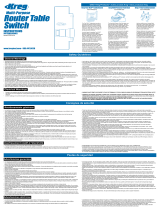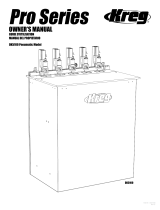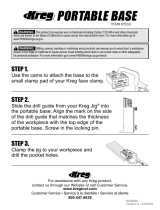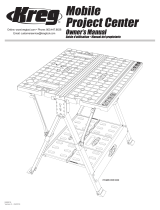Page is loading ...

(
24" x 32"
)
Tools Required:
• Phillips-head screwdriver
• Straight-slot screwdriver
• Electric drill or drill press
Precision Router Table Top
OWNER’S MANUAL
GUIDE D’UTILISATION • MANUAL DEL PROPIETARIO
Item# PRS1025
Article #PRS1025
NK8854
Outils nécessaires :
1
8
o
• Forets
• Fraise
Herramientas necesarias:
1
8
• Brocas para taladro

2
General Safety Instructions
1) Work area safety
a) Keep work area clean and well lit. Cluttered or dark areas invite accidents.
b) Don’t use power tools in a dangerous environment. Don’t use power tools in damp
or wet locations, or expose them to rain.
c) Do not operate power tools in explosive atmospheres, such as in the presence
of ammable liquids, gases or dust. Power tools create sparks that can ignite the
fumes or dust.
d) Keep children and bystanders away while operating a power tool. Distractions
can cause you to lose control.
e) Make your workshop child proof. Use padlocks, master switches, or remove starter
keys.
2) Electrical safety
a) Ground electric tools. If the tool is equipped with a three-prong plug, it should
only be plugged into a grounded three-hole electrical outlet. If the proper outlet is
not available, have one installed by a qualied electrician. Never remove the third prong
or modify the provided plug in any way.
b) Do not expose power tools to rain or wet conditions. Water entering a power tool
will increase the risk of electric shock.
c) Do not abuse the cord. Never use the cord for carrying, pulling or unplugging the
power tool. Keep cord away from heat, oil, sharp edges or moving parts. Damaged or
entangled cords increase the risk of electric shock.
d) Use a proper extension cord and make sure it is in good condition. When using
an extension cord, be sure to use one heavy enough to carry the current your power
tool draws. An undersized cord causes a drop in line voltage resulting in loss of power
and overheating. Table 1 on the following page shows the correct cord gauge to use
depending on cord length and tool nameplate ampere rating. If in doubt, use the next
heavier gage. The smaller the gage number, the heavier the cord.
e) When operating electric tools, avoid body contact with grounded or earthed
surfaces such as pipes, radiators, kitchen ranges, and refrigerators. Contact with a
grounded surface increases the risk of electric shock.
3) Personal safety
a) Stay alert, watch what you are doing and use common sense when operating
a power tool. Do not use a power tool while you are tired or under the inuence of
drugs, alcohol or medication. A moment of inattention while operating power tools may
result in serious personal injury.
b) Always wear safety glasses. Everyday eyeglasses are not safety glasses. Safety
glasses have specially constructed lenses, frames, and side shields.
c) Use safety equipment. Use a face or dust mask when the cutting operation is dusty.
Safety equipment such as a dust mask, non-skid safety shoes, hard hat, or hearing
protection used for appropriate conditions reduces personal injuries.
d) Avoid accidental starting. Make sure the switch is in the off-position before
plugging in. Carrying power tools with your nger on the switch or plugging in power
tools that have the switch on invites accidents.
e) Remove any adjusting key or wrench before turning the power tool on. A wrench
or a key left attached to a rotating part of the power tool may result in personal injury.
f) Do not overreach. Keep proper footing and balance at all times. This enables
better control of the power tool in unexpected situations.
g) Secure workpieces. Use clamps or a vise to hold work when practical. This is safer
than using your hand and it frees both hands to operate the tool.
h) Never stand on the machine. Serious injury could occur if the tool tips or if the cutting
tool is unintentionally contacted.
i) Dress properly. Do not wear loose clothing or jewelry. Keep your hair, clothing
and gloves away from moving parts. Loose clothes, jewelry or long hair can be
caught in moving parts. Roll up long sleeves to the elbow. Wear protective hair covering
to contain long hair.
j) If devices are provided for the connection of dust extraction and collection
equipment, ensure these are connected and properly used. Use of these devices
can reduce dust-related hazards.
4) Power tool use and care
a) Keep guards in place and in working order.
b) Do not force the power tool. Use the correct power tool for your application. The
correct power tool will do the job better and safer at the rate for which it was designed.
c) Use the right tool. Don’t force a tool or attachment to do a job for which it was not
designed.
d) Do not use the power tool if the switch does not turn it on and off. Any power tool
that cannot be controlled with the switch is dangerous and must be repaired.
e) Disconnect the plug from the power source and/or the battery pack from the
power tool before making any adjustments, changing accessories, or storing
power tools. Such preventive safety measures reduce the risk of starting the power tool
accidentally.
f) Never leave a tool running unattended. Turn power off. Don’t leave the tool until it
comes to a complete stop.
g) Store idle power tools out of the reach of children and do not allow persons
unfamiliar with the power tool and these instructions to operate the power tool.
Power tools are dangerous in the hands of untrained users.
h) Maintain power tools. Check for misalignment or binding of moving parts,
broken parts, and any other condition that may affect power tool operation. If
damaged, have the power tool repaired before use. Many accidents are caused by
poorly maintained power tools.
i) Keep cutting tools sharp and clean. Properly maintained cutting tools with sharp
cutting edges are less likely to bind and are easier to control.
j) Use the recommended speed for the cutting tool or accessory and workpiece
material.
k) Only use parts and accessories recommended by the manufacturer. Consult the
owner’s manual for recommended accessories. Using improper accessories may cause
personal injury.
l) Use the power tool, accessories, and tool bits in accordance with these
instructions and in the manner intended for the particular type of power tool,
taking into account the working conditions and the work to be performed. Use of
the power tool for operations different from those intended could result in a hazardous
situation.
5) Service
a) Have your power tool serviced by a qualied repair person using only identical
replacement parts. This ensures that the safety of the power tool is maintained.
6) Safety Instructions specic to using the Precision Router Table Top tted
with a fence.
a) Read, understand, and follow your router manufacturer’s safety warnings
and instructions.
b) Disconnect the router from power before making adjustments. Never
adjust the fence, plate, reducing rings, or any part of the router or router table
while the router is running.
c) Place the router table on a at surface to prevent tipping or sliding.
Never stand on the router table.
d) Do not attempt to rout warped, twisted, or bowed workpieces. All
workpieces must have at faces and square edges.
e) Do not attempt to rout very large workpieces on a router table.
Very large workpieces can be difcult to control and can cause the router table to
tip over.
f) Only use router bits in your router. Never use tools such as carving burrs,
mounted abrasives, wire wheels, or drill pits, even if the shanks match the
diameter of the router collet.
g) Wear gloves when handling router bits. Cutting edges are sharp.
h) Never use dirty, dull, or damaged router bits. Remove wood-resin build-up
with a cleaner specically formulated for cutting tools. Have dull bits sharpened by
a qualied person. Discard damaged bits.
i) Make sure at least 75% of the router-bit shank length is securely held in the
router collet. To ensure a secure hold, leave
1
⁄16 to
1
⁄8 (2mm-3mm) between
the end of the bit shanks and the bottom of the collet.
j) Use the insert-plate reducing ring with the smallest opening that allows the
bit to pass through it. A large gap around the bit can allow the workpiece to tip
!
WARNING When using electric tools, always follow the safety precautions below to reduce risk of re, electric shock, and personal injury. Read
all these instructions before attempting to operate this product. SAVE THESE INSTRUCTIONS.

3
General Safety Instructions
into the bit and kick back.
k) Position the fence faces as close as possible to the bit. Turn the bit by hand
to check for interference. Firmly tighten the fence-face T-knobs before routing.
l) Adjust router speed to match the diameter of the bit. Reduce router speed
when using large-diameter bits. See Table 2 for recommended router speeds.
m) Make sure the router motor is securely clamped in the base before
starting the router.
n) Always support the workpiece with the fence or start pin. Only use the
starter pin with router bits that have a guide bearing.
o) When using the fence, always position the bit guard over the router bit
and as close to the workpiece surface as possible.
p) Never remove a large quantity of stock in one cut. Make several
progressively deeper cuts, adjusting the router bit or fence position between cuts.
q) Keep hands away from the rotating bit and your body out of the path of
the cut. Always use the bit guard, Use push sticks, push blocks, and feather
boards whenever possible, especially when routing narrow workpieces. Turn off
the router before clearing parts of scrap.
r) Avoid awkward hand positions, where a sudden slip could cause contact
with the rotating bit. Never overreach.
s) Avoid routing small parts. Rout the prole on a large workpiece and then cut
the part to nal size from the large workpiece. If you must rout a small part, build
an appropriate jig or hold the part with a wood handscrew clamp.
t) Make sure the workpiece is clear of the bit and the bit comes to a complete
stop before adjusting the workpiece position. Never start the router with the
workpiece in contact with the bit.
u) Avoid kickbacks. Kickbacks occur when the workpiece binds or lifts off
the table while being routed, causing it to be thrown back toward the
operator. To avoid kickbacks and potential injury, use sharp bits, keep the
machine aligned and maintained properly, and adequately support the workpiece.
Do not attempt to rout workpieces that are twisted, warped, or bowed, or that have
loose knots.
v) Feed the workpiece against (not with) the bit rotation. The bit can grab a
workpiece fed with the rotation of the bit, violently eject it from the router table, and
can cause your hand to contact the bit.
w) Never trap a workpiece between the bit and the fence. When forming a
prole on the straight edge of a workpiece, always rout with the bit housed in the
fence and the edge of the workpiece against the fence.
x) Whenever routing a prole in which material is not being removed below a
protruding portion of the bit, or a part of the prole is trapped between
cutters above and below, take extra precautions to prevent the workpiece
from lifting off the table surface during routing. A workpiece lifting off the table
can kick back and cause serious personal injury. When routing these proles, it is
especially important to use straight, at stock and avoid warped, bowed, or twisted
stock.
y) Periodically check the tightness of fasteners and adjustment and locking
knobs and the alignment of the fence. Loose fasteners and knobs and a
misaligned fence can cause personal injury.
z) This router table is designed for a specic application. Do not modify and
or use it for any other application. If you have questions relative to the
application of the router table, DO NOT use it until you have contacted Kreg Tool
Company and have been advised accordingly.
Guidelines for extension cord use
Extension cords are only to be used for temporary purposes. They do not replace the
need for installation of outlets and proper wiring where necessary.
In the shop and on construction sites:
1. Extension cords with an equipment grounding conductor must be used at all
times.
2. Extension cords must be protected from damage, and not run through doorways
or windows where the doors or windows can close, causing damage to the cord.
3. Extension cords must be a minimum of 16 AWG and be rated for the equipment
in use.
4. Extension cords must be periodically inspected to ensure that the insulation and
conductivity of the wires are not compromised.
5. Extension cords should not be run through water or allowed to have connections
that may be exposed to accumulated water.
Always follow bit manufacturer’s speed recommendations. Some bit designs require
specic speeds for safety or performance.
Nameplate
Amperes
@120 V
25
0 -5 14 12 12
5.1 - 8 14 12 10 NR
8.1 -12 14 14 12 10 NR NR
12 12 NR NR NR NR
NR – Not Recommended
TABLE 1
www.kregtool.com • 800.447.8638
For assistance with any Kreg product, contact us through
our Web site or call Customer Service.
TABLE 2
Recommended Router Bit Speeds
Bit Diameter Maximum Speed (RPM)
24,000
18,000
12,000
WARNING:
!
This product can expose you to chemicals including Acrylonitrile
and other chemicals, which are known to the State of California to cause cancer
and reproductive harm. For more information go to www.P65Warnings.ca.gov.
WARNING:
!
Drilling, sawing, sanding or machining wood products can
expose you to wood dust, a substance known to the State of California to cause
cancer. Avoid inhaling wood dust or use a dust mask or other safeguards for
personal protection. For more information go to www.P65Warnings.ca.gov/wood.

4
Item# Description Kreg Part# Quantity
Parts
1
Table top NK8324 1
Combo-Trak NK8151 1
5mm system screws 20mm long NK8025 3
Struts RT10171 2
¾ coarse-thread screws, 8-pack RT10199 1
#2 square driver bit D6 1
Insert-plate levelers RT10100 4
1¼ coarse-thread screws SML-C125 12
⅛ hex wrench AW18 1
¼-20 x 1½ set screws RT10111 8
Insert plate NK8840 1
¼-20 x 1¾ athead machine screws RT10112 4
¼-20 x ¾ set screw DK1522 1
Starting pin RT10108 1
1 reducing ring NK7773 1
Guide-bushing reducing ring NK7775 1
2⅝ reducing ring NK7774 1
Ring wrench NK8003PP 1
Item# Description Kreg Part# Quantity
2
3
4
5
6
7
8
9
Exploded View
10
11
12
13
14
15
16
17
18
1
2
3
4
7
8
9
10
11
12
13
14
15
16
17
18
5
6

5
¼-20 x 1½ set screws RT10111 8
Insert plate NK8840 1
¼-20 x 1¾ athead machine screws RT10112 4
¼-20 x ¾ set screw DK1522 1
Starting pin RT10108 1
1 reducing ring NK7773 1
Guide-bushing reducing ring NK7775 1
2⅝ reducing ring NK7774 1
Ring wrench NK8003PP 1
1
(1)
(2)
(3)
Assemble the top
2
(4) with
(5)(6).
Assembly
3
(7)
(8).
4
(9), drive a set screw (10)
!
ATTENTION(5)
screws (8).
9
10
3
2
1
4
5
8
7

6
Assembly
3
4
Mount your router to the insert plate
1
(11)
!
ATTENTION
!
ATTENTION The included insert plate has center points molded into the bottom
face for drilling mounting holes for the following routers: Pattern 1 (three holes):
Bosch 1617 and 1618; DeWalt 616 and 618; Hitachi M12VC; Makita 1100; Milwaukee
5616 and 5624; Porter-Cable 690, 890, 7529, 97529, and 8529; and Ridgid 2930
Combo Kit. Pattern 2 (four holes): Milwaukee 5625-20; Porter-Cable 7518, 7519,
7538, and 7539; and Triton TRA001 and MOF001. Drill holes and counterbores
or countersinks to accommodate the mounting screws supplied with the router.
For routers equipped with a built-in lift system, use the router sub-base as a
guide for the location and size of the access hole and as a drilling guide.
For routers not covered by Pattern 1 or Pattern 2 follow the instructions below.
P1
P2
P1
P1
P2
P2
P2
2
11

7
Assembly
2
Thread the set screw (13)(14)
(9).
!
ATTENTION
1
(9)
screws (12)
Install the insert plate
9
12
13
14
9
Safety Instructions specic to using the Precision Router Table Top tted with a fence
a) Read, understand, and follow your router manufacturer’s safety warnings
and instructions.
b) Disconnect the router from power before making adjustments. Never
adjust the fence, plate, reducing rings, or any part of the router or router table
while the router is running.
c) Place the router table on a at surface to prevent tipping or sliding.
Never stand on the router table.
d) Do not attempt to rout warped, twisted, or bowed workpieces. All
workpieces must have at faces and square edges.
e) Do not attempt to rout very large workpieces on a router table.
Very large workpieces can be difcult to control and can cause the router table to
tip over.
f) Only use router bits in your router. Never use tools such as carving burrs,
mounted abrasives, wire wheels, or drill pits, even if the shanks match the
diameter of the router collet.
g) Wear gloves when handling router bits. Cutting edges are sharp.
h) Never use dirty, dull, or damaged router bits. Remove wood-resin build-up
with a cleaner specically formulated for cutting tools. Have dull bits sharpened by
a qualied person. Discard damaged bits.
i) Make sure at least 75% of the router-bit shank length is securely held in the
router collet. To ensure a secure hold, leave
1
⁄16 to
1
⁄8 (2mm-3mm) between
the end of the bit shanks and the bottom of the collet.
j) Use the insert-plate reducing ring with the smallest opening that allows the
bit to pass through it. A large gap around the bit can allow the workpiece to tip
into the bit and kick back.
k) Position the fence faces as close as possible to the bit. Turn the bit by hand
to check for interference. Firmly tighten the fence-face T-knobs before routing.
l) Adjust router speed to match the diameter of the bit. Reduce router speed
when using large-diameter bits. See Table 2 for recommended router speeds.
m) Make sure the router motor is securely clamped in the base before
starting the router.
n) Always support the workpiece with the fence or start pin. Only use the
starter pin with router bits that have a guide bearing.
o) When using the fence, always position the bit guard over the router bit
and as close to the workpiece surface as possible.
p) Never remove a large quantity of stock in one cut. Make several
progressively deeper cuts, adjusting the router bit or fence position between cuts.
q) Keep hands away from the rotating bit and your body out of the path of
the cut. Always use the bit guard, Use push sticks, push blocks, and feather
boards whenever possible, especially when routing narrow workpieces. Turn off
the router before clearing parts of scrap.
r) Avoid awkward hand positions, where a sudden slip could cause contact
with the rotating bit. Never overreach.
s) Avoid routing small parts. Rout the prole on a large workpiece and then cut
the part to nal size from the large workpiece. If you must rout a small part, build
an appropriate jig or hold the part with a wood handscrew clamp.
t) Make sure the workpiece is clear of the bit and the bit comes to a complete
stop before adjusting the workpiece position. Never start the router with the
workpiece in contact with the bit.
u) Avoid kickbacks. Kickbacks occur when the workpiece binds or lifts off
the table while being routed, causing it to be thrown back toward the
operator. To avoid kickbacks and potential injury, use sharp bits, keep the
machine aligned and maintained properly, and adequately support the workpiece.
Do not attempt to rout workpieces that are twisted, warped, or bowed, or that have
loose knots.
v) Feed the workpiece against (not with) the bit rotation. The bit can grab a
workpiece fed with the rotation of the bit, violently eject it from the router table, and
can cause your hand to contact the bit.
w) Never trap a workpiece between the bit and the fence. When forming a
prole on the straight edge of a workpiece, always rout with the bit housed in the
fence and the edge of the workpiece against the fence.

8
Reducing Rings
Starting Pin
!
!
15
16 17
or
or
18
Safety Instructions specic to using the Precision Router Table Top tted with a fence
Using your Precision Router Table Top
A
E
B
C
D
x) Whenever routing a prole in which material is not being removed below a
protruding portion of the bit, or a part of the prole is trapped between
cutters above and below, take extra precautions to prevent the workpiece
from lifting off the table surface during routing. A workpiece lifting off the table
can kick back and cause serious personal injury. When routing these proles, it is
especially important to use straight, at stock and avoid warped, bowed, or twisted
stock.
y) Periodically check the tightness of fasteners and adjustment and locking
knobs and the alignment of the fence. Loose fasteners and knobs and a
misaligned fence can cause personal injury.
z) This router table is designed for a specic application. Do not modify and
or use it for any other application. If you have questions relative to the
application of the router table, DO NOT use it until you have contacted Kreg Tool
Company and have been advised accordingly.
General Routing
(A)
(B)
(C)
(D)
(E)

Kreg Tool Company, 201 Campus Drive, Huxley, IA 50124
800.447.8638 • www.kregtool.com
/











